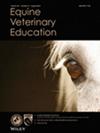Outcome and survival of septic arthritis treated with 0.05% chlorhexidine solution: Description of 10 cases
Abstract
Background
Established or ongoing septic arthritis requiring repeated joint flushing remains a treatment challenge with a poor survival outcome aggravated by the necessity of controlled antimicrobial usage.
Objective
To describe the outcomes and survival rates of patients with synovial sepsis treated by lavage with a 0.05% chlorhexidine solution.
Study design
Clinical retrospective observational study.
Methods
Patients with synovial sepsis underwent standing needle or arthroscopic lavage under general anaesthesia with a 0.05% chlorhexidine solution, followed by Lactate Ringer Solution (LRS). Complementary systemic and regional antibiotics were used. Short- (6 months) and long-term (>1 year) outcomes were assessed.
Results
Ten horses met the inclusion criteria. Affected joints included metacarpophalangeal joints (2), tarsocrural joint (1), radiocarpal and intercarpal joints (2), distal interphalangeal joints and navicular bursa (3), distal interphalangeal joints (2). Time from onset to referral ranged from 1 to 20 days, with a mean of 8.3 days. Eighty per cent of horses survived for more than 1 year. Four horses were retired to the field, three returned to a light level of work and one went back to full work.
Main limitations
Retrospective study of a limited group of horses initially treated by different clinicians before referral, as such, first-line treatment had differences between cases. Resolution was evaluated on based clinical signs rather than clinical pathology of synovial fluid due to clinical decisions or difficulty in obtaining samples.
Conclusion
With this series of challenging synovial sepsis cases treated by lavage with a chlorhexidine solution, we provide a treatment protocol, proof of clinical concept and report patients' short- and long-term clinical outcomes. Short- and long-term postoperative lameness should be expected despite the resolution of the septic arthritis. This treatment poses a novel option for challenging cases but should be regarded as a salvage procedure due to the possibility of long-term mild lameness.




 求助内容:
求助内容: 应助结果提醒方式:
应助结果提醒方式:


